Tibet
Locations in this report:
- Pokhara - Show on the map
- Pokhara - Show on the map
- Junbesi - Show on the map
- Zhangmu Border - Show on the map
- Nyalam - Show on the map
- Tong La - Show on the map
- Gyanse - Show on the map
- Lhasa - Show on the map Show complete route
Written: 23.05.2012 12:34:46
After the Annapurna Trek, we've been a few days in Pokhara and another Trek in Nepal, to Junbesi.
These reports exists in writing, I will type, insert pictures an upload them later.
-----------
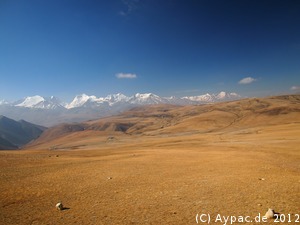 So this morning we would go to Tibet. With a mass-tourist budget-tour (which is still like a hundred dollars a day). In the country which's culture is getting destroyed by the Chinese.
So this morning we would go to Tibet. With a mass-tourist budget-tour (which is still like a hundred dollars a day). In the country which's culture is getting destroyed by the Chinese.
But still it would be Tibet - the roof of the world.
We moved to a hotel near the place we would start from - Thamel - because the tour would start at 6:30 with a breakfast. We were kinda surprised what kind of people were on this breakfast (so on our tour). Soon first friendships were made.
The first half day ride was still in Nepal to the Zhangmu Border to Tibet.
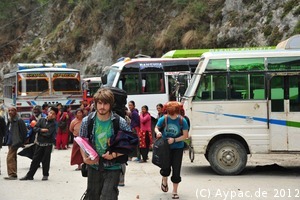 The border was amazing. It is actually a river - on the one side Nepal on the other China. The Nepal border station is really small and is just a room in a regular building. Over the river there is a bridge. In the middle of the bridge there is a red line marking the border.
The border was amazing. It is actually a river - on the one side Nepal on the other China. The Nepal border station is really small and is just a room in a regular building. Over the river there is a bridge. In the middle of the bridge there is a red line marking the border.
But on the other side you already see the golden letters on a massive building (of course a concrete block) welcoming you to China. When you leave the bridge you pass a gate - on each side there are soldiers standing in glass boxes - not moving at all.
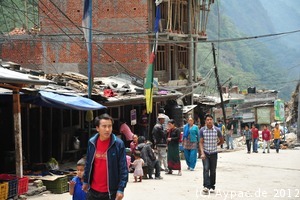 Then you pass the most modern overland border station I've seen so far. Face recognition, different kinds of X-RAY, cameras everywhere, modern counters etc. Your complete luggage will be searched for books and other stuff the Chinese don't like (they don't even allow the Lonely Planet Tibet!) - they even started my laptop and were watching the documentary on the desktop a friend of mine made. But they couldn't find the pictures I took of the Lonely Planet pages which would be important for us.
Then you pass the most modern overland border station I've seen so far. Face recognition, different kinds of X-RAY, cameras everywhere, modern counters etc. Your complete luggage will be searched for books and other stuff the Chinese don't like (they don't even allow the Lonely Planet Tibet!) - they even started my laptop and were watching the documentary on the desktop a friend of mine made. But they couldn't find the pictures I took of the Lonely Planet pages which would be important for us.
Our guide was waiting for us - and seemingly we had luck - he was a Tibetian. After about three month of left-side driving I was searching for the door of the bus on the wrong side - china is a right-side driving country again. After about an hour ride up the hill we reached a check-point, which took us about three hours to pass, because the people who should check our permit where in conference.
Later we stopped at the passes Lalung-La (5.050m) and Tong La (5150m).
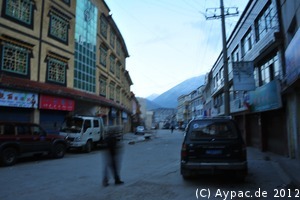 In the evening we finally reached our first hotel in Nyalam. It had dormitories so everybody had to share rooms. It was a simple place. But I like places like this. Way better than having your own room! And we got a Thermos of hot water (people here seem to drink hot water with little or no spices as tea).
In the evening we finally reached our first hotel in Nyalam. It had dormitories so everybody had to share rooms. It was a simple place. But I like places like this. Way better than having your own room! And we got a Thermos of hot water (people here seem to drink hot water with little or no spices as tea).
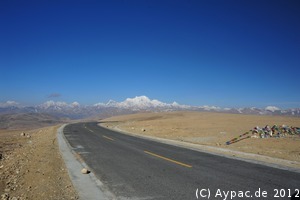 The included breakfast was at 7:30 (and ridiculously small) and after that we went straight on. The landscape was getting plainer, though we were still driving uphill. It was getting more and more how you image the high-plateau of Tibet: No plants or other green just brown in brown and hills around and in the distance the hight mountain-tops of Everest & Co. It's like a dessert.
The included breakfast was at 7:30 (and ridiculously small) and after that we went straight on. The landscape was getting plainer, though we were still driving uphill. It was getting more and more how you image the high-plateau of Tibet: No plants or other green just brown in brown and hills around and in the distance the hight mountain-tops of Everest & Co. It's like a dessert.
On our first stop we saw some "houses" which looked weird and quite ugly (see picture). After puzzling myself for a while I asked our guide, who was telling us, that these were greenhouses, built by the Chinese. "That is a good thing, before that nothing grew here!", he told me.
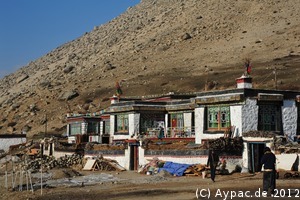
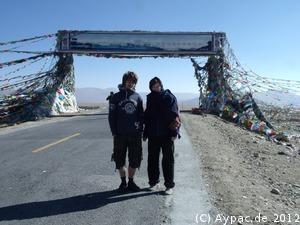 Gyatso La (5,260m - highest pass en route) - both with most beautiful views. After these passes we started to go downhill. Nearly everybody of us started to get slight to heavy headaches, because of the altitude.
Gyatso La (5,260m - highest pass en route) - both with most beautiful views. After these passes we started to go downhill. Nearly everybody of us started to get slight to heavy headaches, because of the altitude.
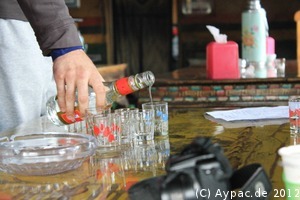 On the second day (the 9th of May), the two Russians of our group got out a bottle of Vodka during lunch and announced that it was Victory Day - the day when the German lost WW2, always a big celebration in Russia. And so everybody drank, despite the altitude, a shot together!
On the second day (the 9th of May), the two Russians of our group got out a bottle of Vodka during lunch and announced that it was Victory Day - the day when the German lost WW2, always a big celebration in Russia. And so everybody drank, despite the altitude, a shot together!
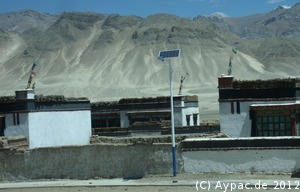 On the road you could see many projects by the Chinese: Solar stations everywhere, street lights, police stations in every bigger village, mines, checkpoints, water drainages, power lines and of course the Friendship Highway (the road we were riding on). All these projects are made most professional. When we came near Shigatse (Xigatse), they even started to plant huge forests. Image: They plant forests basically in a dessert and above the tree-line (still about 4000m above see level!).
On the road you could see many projects by the Chinese: Solar stations everywhere, street lights, police stations in every bigger village, mines, checkpoints, water drainages, power lines and of course the Friendship Highway (the road we were riding on). All these projects are made most professional. When we came near Shigatse (Xigatse), they even started to plant huge forests. Image: They plant forests basically in a dessert and above the tree-line (still about 4000m above see level!).
 If all that (except for the forests) wasn't so unbelievably ugly, you wouldn't know that it was to destroy the Tibetian culture and to allow more and more Chinese to live in that area and all you see on the tour is EXACTLY what you're supposed to see, you might think China was the most efficient and best development helper on this planet. It still impresses and scares me at the same time. They do what ever they want without any compromises. And though everybody knows that they do evil, no one can do anything against it. And still raising...
If all that (except for the forests) wasn't so unbelievably ugly, you wouldn't know that it was to destroy the Tibetian culture and to allow more and more Chinese to live in that area and all you see on the tour is EXACTLY what you're supposed to see, you might think China was the most efficient and best development helper on this planet. It still impresses and scares me at the same time. They do what ever they want without any compromises. And though everybody knows that they do evil, no one can do anything against it. And still raising...
Shigatse was another monument of that thing: A huge city in the middle of the dessert. Wide and impressive streets, police checkpoints on every corner, modern big houses, even some skyscrapers. Just because they can!
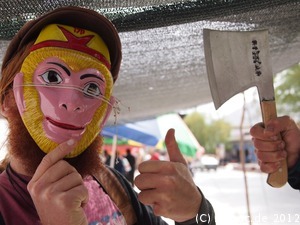 The breakfast was at 9:30 so we could sleep long, but in fact I woke up every half hour from 5AM, with a terrible headache, drank some water, went to toilet and back to bed (best treatment against Altitude Sickness). After the breakfast we had some free-time to explore the city. Rike struggeling under altitude and a otitis went back after a short while.
The breakfast was at 9:30 so we could sleep long, but in fact I woke up every half hour from 5AM, with a terrible headache, drank some water, went to toilet and back to bed (best treatment against Altitude Sickness). After the breakfast we had some free-time to explore the city. Rike struggeling under altitude and a otitis went back after a short while.
We had great fun walking through a tibetian market (though a lot of Chinese "plastic-products" are sold there, too). There were plenty of BB-guns and plastic bows as well as plastic swords. We planned a big fight An Australian guy and I were examining hand-made 19th century general dresses, and he finally bought one. I got myself a red local dress I kinda liked.
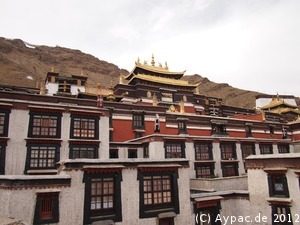 At 3Pm we met at the hotel again to see the Tashilhunpu monastery. It is a nice monastery, though I think without all that power-lines and the view on the sky-scrapers of the city it would be even more awesome. The best was the prayer-room. The atmosphere in that room was so calm wise and endless. Hard to describe. It's a pity but I can't show you pictures of most of the rooms (otherwise I had to pay between 50-150Yuan (7-20?) per room).
At 3Pm we met at the hotel again to see the Tashilhunpu monastery. It is a nice monastery, though I think without all that power-lines and the view on the sky-scrapers of the city it would be even more awesome. The best was the prayer-room. The atmosphere in that room was so calm wise and endless. Hard to describe. It's a pity but I can't show you pictures of most of the rooms (otherwise I had to pay between 50-150Yuan (7-20?) per room).
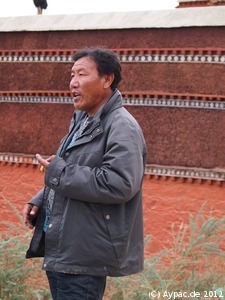 The guide was doing a good job and telling us a lot of things, until it came to the story with the 11th Panchen Lama (who is most likely under house arrest by Chinese government and they chose a new one to take over control over Tibet). When it came to that topic he said "There are different stories, but I'm not allowed to talk about it.".
The guide was doing a good job and telling us a lot of things, until it came to the story with the 11th Panchen Lama (who is most likely under house arrest by Chinese government and they chose a new one to take over control over Tibet). When it came to that topic he said "There are different stories, but I'm not allowed to talk about it.".
In the evening we started watching Rum Diary on my laptop. From now on we only had really nice hotel double rooms (I guess something about 3 Stars). Of course with some beer (though still consisting headache).
Breakfast at 8 and two hour ride to Gyanse. In Gyanse there is another big monastery (though it only hosts 66 monks nowadays, it once were once upon a time up to 10.000!!!) with a long and interesting history. The first time it was destroyed by the British and rebuild later. Then it got destroyed during the "revolution" (that is what our guide calls the invasion by the Chinese) and the 11. Panchen Lama rebuilt it partly. But one hall was neither by the British nor by the Chinese destroyed and they stored "books" and other religious item in it. These ancient (some up to 1000years old) "books" (there are more like stripes of paper stacked up and wrapped in fabric) are still to be found in one room. It is an awkward and awesome feeling at the same time.
We checked out the Yak Restaurant later. It has Yak Burgers on the menu, which I unfortunately could not check out due to the fact that I'm still vegetarian. We stayed there for a whole while. The group is just close to perfect and it never gets boring talking, joking, telling stories and drinking beer together.
Later finishing Rum Diary (de facto starting over again, because a few more were joining us).
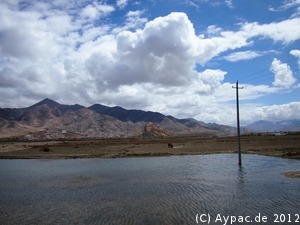 The ride to Lhasa was quite long, but we stopped a few times for lakes. Lakes in Tibet are just beautiful. The color of the water is of such a beautiful blue and green as you can barely image!
The ride to Lhasa was quite long, but we stopped a few times for lakes. Lakes in Tibet are just beautiful. The color of the water is of such a beautiful blue and green as you can barely image!
The closer we came to Lhasa the bigger the streets got, the more power-lines and rails you could see and there were plenty of tunnels to cross. Streets got wide and there were junctions with unbuild roads (for future extensions). After crossing two major bridges we came into the real city. But it only consists of modern concrete houses, skyscrapers and long, straight and wide roads.
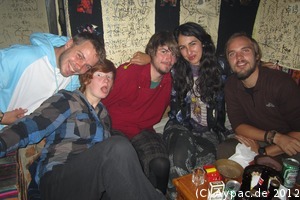 Our Hotel was near a market and after sorting all our stuff we went in small groups for exploration and in the evening in a bar for a few (more) drinks.
Our Hotel was near a market and after sorting all our stuff we went in small groups for exploration and in the evening in a bar for a few (more) drinks.
Though it got late that evening, breakfast was at 8 and after that we went straight to the Jokhang Temple, next to the market we've been exploring the other day. Though it is incredible crowded by mostly Chinese tourists, it is a most impressive building. Maybe it was just the massively used incense, but I though the statue of the Future Buddha was breathing and looking at me.
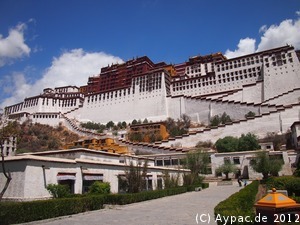 Next was the absolute highlight of the trip: The most famous Potala Palace (the palace of the Dalai Lama). After X-Ray check of our luggage, we entered the garden, from where there are many stairs up to the palace. It was exhausting for everyone. That's not due to the amount of stairs alone, but the place is round about 4000m above sea level and we've only been sitting in the bus so far. Additionally the sun is really burning up there!
Next was the absolute highlight of the trip: The most famous Potala Palace (the palace of the Dalai Lama). After X-Ray check of our luggage, we entered the garden, from where there are many stairs up to the palace. It was exhausting for everyone. That's not due to the amount of stairs alone, but the place is round about 4000m above sea level and we've only been sitting in the bus so far. Additionally the sun is really burning up there!
The palace is really impressive and interesting, though only a few rooms are open to tourists. Besides the praying- and teaching room, the foyer and the roof(!) we saw the graves of the previous Dalai Lama's. They are huge things, which look a little like stupas and are gilded in gold and semi-precious stones. The biggest one has over 4.5tons (!) of gold on it and an impressive work of semi-precious stones. I wish I could show you pictures, but for religious or other reasons, it's not allowed to take picture (not even for money :D).
Because we only had 2 days left in Lhasa we went to the train station to buy our tickets (some had already or were flying back, though). The train station was outside the city and simply massive. Obviously the Chinese have big plans with Lhasa.
Again A lot of fun drinking in the hotel-room and later in a local bar, where some Chinese invited us for a lot of drinks (especially some milky liquid which tasted a little like rice-beer).
After again just a few hours of sleep we had the same breakfast as the day before and went to see two monasteries.
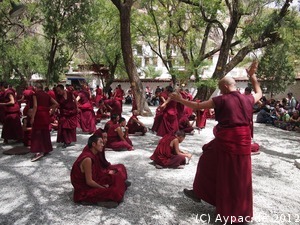 One of them had a so called Discussion court. It is a round area, surrounded by walls (and of course under video-surveillance), where always two monks are a group and ask each other questions (for practice of facts/knowledge or for real discussion, we couldn't find out). One of them is standing and asking, the other one answering them. As soon as the question is finished, the questioner claps with his hands. If the answer is right the next questions comes, if the answer is wrong, he claps in his hands in the other direction (see pictures).
One of them had a so called Discussion court. It is a round area, surrounded by walls (and of course under video-surveillance), where always two monks are a group and ask each other questions (for practice of facts/knowledge or for real discussion, we couldn't find out). One of them is standing and asking, the other one answering them. As soon as the question is finished, the questioner claps with his hands. If the answer is right the next questions comes, if the answer is wrong, he claps in his hands in the other direction (see pictures).
Celebrating our last evening in Lhasa, the last evening of our trip and for most of us the last evening together we got to bed late again.
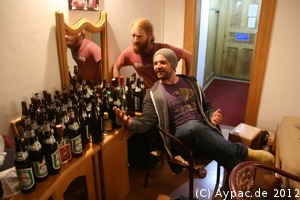
These reports exists in writing, I will type, insert pictures an upload them later.
-----------
But still it would be Tibet - the roof of the world.
We moved to a hotel near the place we would start from - Thamel - because the tour would start at 6:30 with a breakfast. We were kinda surprised what kind of people were on this breakfast (so on our tour). Soon first friendships were made.
The first half day ride was still in Nepal to the Zhangmu Border to Tibet.
 The border was amazing. It is actually a river - on the one side Nepal on the other China. The Nepal border station is really small and is just a room in a regular building. Over the river there is a bridge. In the middle of the bridge there is a red line marking the border.
The border was amazing. It is actually a river - on the one side Nepal on the other China. The Nepal border station is really small and is just a room in a regular building. Over the river there is a bridge. In the middle of the bridge there is a red line marking the border.But on the other side you already see the golden letters on a massive building (of course a concrete block) welcoming you to China. When you leave the bridge you pass a gate - on each side there are soldiers standing in glass boxes - not moving at all.
 Then you pass the most modern overland border station I've seen so far. Face recognition, different kinds of X-RAY, cameras everywhere, modern counters etc. Your complete luggage will be searched for books and other stuff the Chinese don't like (they don't even allow the Lonely Planet Tibet!) - they even started my laptop and were watching the documentary on the desktop a friend of mine made. But they couldn't find the pictures I took of the Lonely Planet pages which would be important for us.
Then you pass the most modern overland border station I've seen so far. Face recognition, different kinds of X-RAY, cameras everywhere, modern counters etc. Your complete luggage will be searched for books and other stuff the Chinese don't like (they don't even allow the Lonely Planet Tibet!) - they even started my laptop and were watching the documentary on the desktop a friend of mine made. But they couldn't find the pictures I took of the Lonely Planet pages which would be important for us.Our guide was waiting for us - and seemingly we had luck - he was a Tibetian. After about three month of left-side driving I was searching for the door of the bus on the wrong side - china is a right-side driving country again. After about an hour ride up the hill we reached a check-point, which took us about three hours to pass, because the people who should check our permit where in conference.
Later we stopped at the passes Lalung-La (5.050m) and Tong La (5150m).
 In the evening we finally reached our first hotel in Nyalam. It had dormitories so everybody had to share rooms. It was a simple place. But I like places like this. Way better than having your own room! And we got a Thermos of hot water (people here seem to drink hot water with little or no spices as tea).
In the evening we finally reached our first hotel in Nyalam. It had dormitories so everybody had to share rooms. It was a simple place. But I like places like this. Way better than having your own room! And we got a Thermos of hot water (people here seem to drink hot water with little or no spices as tea). The included breakfast was at 7:30 (and ridiculously small) and after that we went straight on. The landscape was getting plainer, though we were still driving uphill. It was getting more and more how you image the high-plateau of Tibet: No plants or other green just brown in brown and hills around and in the distance the hight mountain-tops of Everest & Co. It's like a dessert.
The included breakfast was at 7:30 (and ridiculously small) and after that we went straight on. The landscape was getting plainer, though we were still driving uphill. It was getting more and more how you image the high-plateau of Tibet: No plants or other green just brown in brown and hills around and in the distance the hight mountain-tops of Everest & Co. It's like a dessert.On our first stop we saw some "houses" which looked weird and quite ugly (see picture). After puzzling myself for a while I asked our guide, who was telling us, that these were greenhouses, built by the Chinese. "That is a good thing, before that nothing grew here!", he told me.

Shigatse was another monument of that thing: A huge city in the middle of the dessert. Wide and impressive streets, police checkpoints on every corner, modern big houses, even some skyscrapers. Just because they can!
We had great fun walking through a tibetian market (though a lot of Chinese "plastic-products" are sold there, too). There were plenty of BB-guns and plastic bows as well as plastic swords. We planned a big fight An Australian guy and I were examining hand-made 19th century general dresses, and he finally bought one. I got myself a red local dress I kinda liked.
In the evening we started watching Rum Diary on my laptop. From now on we only had really nice hotel double rooms (I guess something about 3 Stars). Of course with some beer (though still consisting headache).
Breakfast at 8 and two hour ride to Gyanse. In Gyanse there is another big monastery (though it only hosts 66 monks nowadays, it once were once upon a time up to 10.000!!!) with a long and interesting history. The first time it was destroyed by the British and rebuild later. Then it got destroyed during the "revolution" (that is what our guide calls the invasion by the Chinese) and the 11. Panchen Lama rebuilt it partly. But one hall was neither by the British nor by the Chinese destroyed and they stored "books" and other religious item in it. These ancient (some up to 1000years old) "books" (there are more like stripes of paper stacked up and wrapped in fabric) are still to be found in one room. It is an awkward and awesome feeling at the same time.
We checked out the Yak Restaurant later. It has Yak Burgers on the menu, which I unfortunately could not check out due to the fact that I'm still vegetarian. We stayed there for a whole while. The group is just close to perfect and it never gets boring talking, joking, telling stories and drinking beer together.
Later finishing Rum Diary (de facto starting over again, because a few more were joining us).
The closer we came to Lhasa the bigger the streets got, the more power-lines and rails you could see and there were plenty of tunnels to cross. Streets got wide and there were junctions with unbuild roads (for future extensions). After crossing two major bridges we came into the real city. But it only consists of modern concrete houses, skyscrapers and long, straight and wide roads.
Though it got late that evening, breakfast was at 8 and after that we went straight to the Jokhang Temple, next to the market we've been exploring the other day. Though it is incredible crowded by mostly Chinese tourists, it is a most impressive building. Maybe it was just the massively used incense, but I though the statue of the Future Buddha was breathing and looking at me.
The palace is really impressive and interesting, though only a few rooms are open to tourists. Besides the praying- and teaching room, the foyer and the roof(!) we saw the graves of the previous Dalai Lama's. They are huge things, which look a little like stupas and are gilded in gold and semi-precious stones. The biggest one has over 4.5tons (!) of gold on it and an impressive work of semi-precious stones. I wish I could show you pictures, but for religious or other reasons, it's not allowed to take picture (not even for money :D).
Because we only had 2 days left in Lhasa we went to the train station to buy our tickets (some had already or were flying back, though). The train station was outside the city and simply massive. Obviously the Chinese have big plans with Lhasa.
Again A lot of fun drinking in the hotel-room and later in a local bar, where some Chinese invited us for a lot of drinks (especially some milky liquid which tasted a little like rice-beer).
After again just a few hours of sleep we had the same breakfast as the day before and went to see two monasteries.
Celebrating our last evening in Lhasa, the last evening of our trip and for most of us the last evening together we got to bed late again.